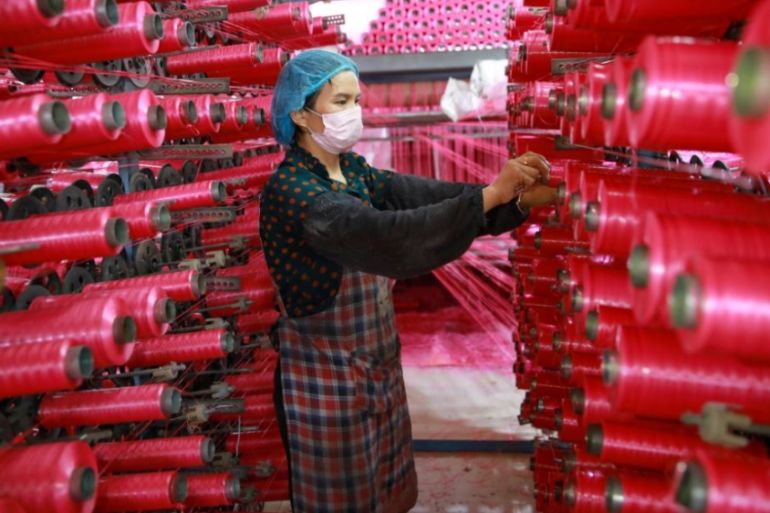Hitting the brakes: China’s economy slows to 27-year low
But stronger-than-expected retail sales and investments suggest government stimulus measures may be working.

Hong Kong, China – Growth in the world’s second-largest economy, China, slowed to its worst pace in nearly three decades in the second quarter of 2019 – but nobody seems to be expressing too much shock or horror about that.
The trade war with the United States that has been going on for a year is hurting China’s factories and exporters, and a slowdown had been widely expected.
Keep reading
list of 4 itemsPolitics and convenience drive Mexico to be US’s top trading partner
Will Xi and Biden mend US-China relations at the APEC summit?
UK warns of Russia laying ‘sea mines’ to deter Black Sea cargo ships
But the real surprises in the latest figures from Beijing came in the form of unexpectedly strong investments and retail sales in June, with the rapid rise of e-commerce emerging as a powerful economic force in its own right.
Growth in gross the domestic product (GDP) – the most commonly used indicator for the size of an economy – slowed to 6.2 percent in the second quarter, down from 6.4 percent in the first three months of the year, according to figures released on Monday by the National Bureau of Statistics.
“Economic growth moderated in [the second quarter], but monthly data suggest that momentum might have picked up [late in the quarter],” Tommy Wu, senior economist at Oxford Economics, told Al Jazeera.
Washington sharply raised tariffs on $200bn of Chinese goods in May, increasing the strain on a struggling manufacturing sector and threatening to crush already-thin profit margins.
Though both sides agreed, in late June, to resume negotiations, and Washington said it would hold off on additional levies, existing tariffs remain in place.
No time frame has been set for the new round of trade talks, and Beijing and Washington remain at odds over significant issues.
Growth stabilising?
To ensure that growth does not slip by too much, Beijing announced tax cuts earlier this year worth nearly two trillion yuan ($291bn) and introduced a raft of other stimulus measures including making credit easier for borrowers.
“We continue to expect Beijing’s stimulus to feed through more strongly in [the second half] of 2019 and for growth to stabilise or even show a slight improvement in the remaining quarters,” Darren Tay, Asia country risk analyst at Fitch Solutions, told Al Jazeera.
Meanwhile, a silver lining to the slowing growth picture was retail sales, which expanded by a faster-than-expected 9.8 percent in June compared with the same month last year, beating analyst forecasts.
Industrial output, reflecting how busy factories were, grew by 6.3 percent last month year-on-year, also exceeding estimates. Companies also invested more heavily than expected in things like land and equipment, so-called fixed assets, which rose by 5.8 percent in the first six months compared to the same period in 2018.
Analysts say these figures suggest the economy in the second half of the year could be stronger than in the first half.
And that turnaround may be due in part to some deeper structural shifts in the Chinese economy.
One of those changes is the rapid growth of e-commerce, analysts say.
“We estimate that e-commerce contributes to about 10 percent of China’s GDP growth as online sales account for 20 percent of total retail, and consumption contributes to 60 percent of GDP growth,” Dan Wang, an analyst at The Economist Intelligence Unit (EIU), told Al Jazeera.
The 40 largest cities in China tracked by The EIU have all registered double-digit growth for e-commerce so far in 2019.
“Lower tier cities are also rising strongly in online retails, helped by improved logistics network and cold chains,” said Wang, referring to refrigerated supplies of food and other products. “The younger generation is a main driving force for online purchase and their spending is supported by easier access to online borrowing platforms, such as JD and Alipay.”
But e-commerce on its own is unlikely to mitigate the negative impact of the trade war, Wang says.
“This is because car sales, the largest component in retail, remains weak,” he said.
But the rise of e-commerce is a double-edged sword, Wang says. Greater online shopping activity tends to crowd out physical stores, especially for clothing and household appliances, likely limiting the positive effects of e-business on overall consumption in China.
Other sectors such as crop farming and services also grew strongly in the second quarter.
But the trade war with the US is likely to continue to cast a shadow on factory output and overall growth for the rest of this year, analysts say.
Tom Rafferty, principal economist for China at The EIU, believes businesses remain sceptical that the two countries will reach a broader trade agreement and recognise that trade tensions may flare up again.